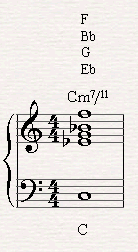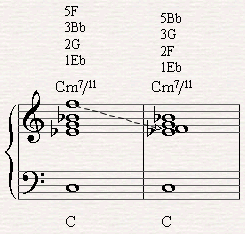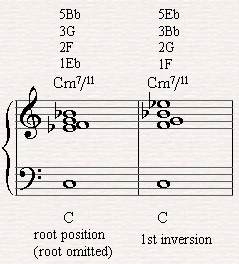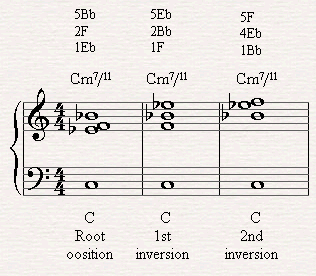Jazz Piano Lessons - Adding The EleventhThis is the second part of our jazz lessons dedicated to adding the 11th note. Click here to preview the first part where we talk about adding the 9th note In this jazz piano lesson we're going us the C chord as the example chord but you can use our chord generation or construct the other jazz chords in the same way. If we take C major as an example we'll see the F is the eleventh note of the scale is F. On the right side you can see how this chord should be played after omitting the root note from the bottom of the chord to prevent the effect of an empty octave between the bass an the bottom note of the chord. 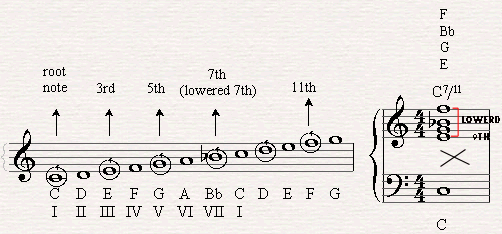 If you play it you'll here that it sounds false. How come? This happens since the inerval between E (the third) and F (the fourth) is of a lowered 9th which is the sharpest sounding interval you'll hear in western music. Now with all the respect to extension we won't let the replace such an important note as the third so we'll never play the natural eleventh with a third in a major chord from now on in our jazz piano lessons (Acceptions will appear later). So when can we add the natural eleventh? In minor chords of course! Since the middle note of the chord is lowered in order to create the minor mood the intervals between the third note of the scale and the eleventh note is of a ninth and not a lowered ninth. Basically what I'm saying is that eleventh chords are mostly minor chords. The third note of scale (Eb in Cm) has to be present in the chord or otherwise the chord would be called eleventh chord but a suspension chord (sus chord). We already discussed sus chord earlier in our jazz piano lessons. Click here to learn about sus chords if you want to... Now we face other problem. The distance between the seventh note (Bb) and the eleventh note (F) is of a fifth. We try to avoid this interval in jazz chord since it is simply too broad and creates a separation in the sound. To avoid that we're going to relocate the eleventh note inside the chord between the third notes (Eb) and the fifth note (G). We're going to keep the conecpt of blending from now on in our jazz piano lessons. The result is that the extension of the chord sounds more friendly within the other voice (when the extension is located on the top it get the most expressive role in the chord).
We end up with Eb, F, G and Bb. The problem with this chord is the lowest three notes are located to close to each other and therefore create an unclear blurring in the sound. Let's step to the next chord inversion then by raising the third note up. Now there's a satisfying distance between the notes. As a matter of fact since the fourth note and the third note are really distanced from each other. They complement each other much more. Here's are all the chord inversions of Cm7/11 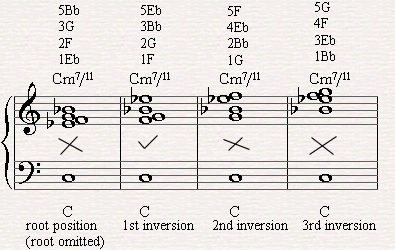 The chord inversion with the fifth note in the bass is unwanted since it will be disturbing possible bass lines in the future and the last chord inversion with the seventh in the bottom is problematic since the upper note G is located to close to F and we already note that we'd like to set the upper note of the chord a bit apart. We're left with only one chord inversion. That's pretty poor... What can we do about it? When we encounter a problem in the spacing of the chord and we'd like to omit another note we will probably omit the fifth note of the chord. When we omit the fifth chord we're actually saying that we don't want to create a triad chord based on thirds anymore but a colorful chord created out of a variety of intervals instead which is the main cause to the special sound of jazz chords. The thing is that the fifth note of the scale is note really relevant to the function of the chord. It is a passive note so by omitting it we get the opportunity to create plenty of space. Now that we've omitted the fifth note we can play the eleventh chord in all three chord inversions. O.k. so to sum up what we've learned so far we can say that the building jazz chords involves a number of considerations such as clashing notes, a matter of functionality and spacing up the upper notes. Let's continue in our jazz piano lessons and learn about adding the 13'th. Click here to learn how to add the 13th to jazz chords.
|
How To Play Piano by ChordsTHE FAST AND EASY WAY TO LEARN PIANO! The Ultimate Piano by Chords Learning Kit "Your entire site is simply fantastic. I really loved it. Now I am learning the basics of piano by myself, with your really great help. Thank you very much!" Jaime C. from Brazil "I only started to play about six weeks ago but the last hour of watching your videos about chord progressions has been something of a revelation. You're brilliant!!!!" Stephen Roberts from U.S.A "I'm a beginning keyboard player and your video's are an excellent guide. You're absolute not in a hurry, and take time to explain. I'm sure I'll follow all your lessons to get the hang of playing the piano/keyboard!" Wouter E. from the Netherlands "Thanks for all your work ( tuto and others ). You're doing a really great job, You're the best internet teacher I know." Anthony Hassen Cohen from France |
||||
|
Enjoy This Site?
Then why not use the button below, to add us to your favorite bookmarking service? |
|||||
|
| Homepage |
Site Map |
Just Added |
Buy Us Coffee! |
Sign up / Freebies |
Recommended Products |
Articles & Reviews |
Blog |
Beginners Course |
Accompaniment Course |
Notes Lessons |
Playing Technique | Chords | Theory| Tutorials | Sheets | Forum | Piano Videos | History | Piano Stuff| Keyboards and Pianos| |
|||||
|
Copyright piano-play-it.com © 2008-2017. | |||||

